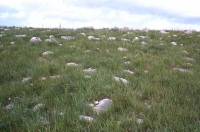The Xeric prairie is most commonly found on steep, southwest hillsides. Often these slopes are so steep that there's continual surface movement of soil particles. Xeric prairies on flat upland sites, such as in southwestern Dane County, have erosion from wind that has the same effect on soil as water erosion has on steep sloped locations. Because of the extreme erosion, the soil blanket over the underlying limestone may average less than 4 inches in depth. Even though the soil blanket is shallow, its ability to hold water and nutrients is still very good. However, because the soil blanket is shallow, the quantity of water and nutrients is greatly limited. Typically, low quantities of water and nutrients in the soil, exposure to high winds, and higher levels of direct sunlight normally indicate dehyrdration or drought in plants that don't allow them to grow, but Xeric prairies don't seem to be affected by these conditions! Studies done by John T. Curtis (a renowned American botanist and plant ecologist) and his students from UW-Madison show that these areas are actually quite luxurious, meaning there is an excess of productivity from these dry plants!
How can this be?
Studies done on the Xeric prairie explains that a significant amount of water is retained not by rainfall (precipitation) but by condensation. Curtis states that "the very exposure which leads to desiccation by midday also increases the net radiation of energy during the night, bringing temperatures below the dew point." This means that if you were to walk through these Xeric prairies in the early morning, even during the hottest and driest months of the year, your shoes would get wet from the high levels of dew on the ground. The organic content in the soil actually acts as a sponge by retaining condensation from the cool nights. It also insulates the surface layers of soil from the stored heat in the underlying bedrock, which helps this plant community grow. The amazing ability for Xeric prairies to retain so much water, despite other conditions, makes this an interesting grassland neighborhood.
Xeric prairies are a wonderful native habitat of Wisconsin, but numbers are dwindling. Be sure to read Part 2 of this blog to learn why these plant communities are being reduced and how we can restore this habitat!





